Interested in Buying Art, but Not Sure Where to Begin? Kayla Carlsen of Sotheby’s Offers Tips for Any Price Point
June 14, 2019 | Filed in: Woman of the Week
As the head of Sotheby’s American Art department, Kayla Carlsen manages auctions where over $30 million changes hands in a matter of hours. But selling and acquiring art isn’t just about the money; it’s also a personal, emotional, and intellectual process. Here, Kayla—who has spent her whole career at auction houses, starting at Christie’s in 2005 and landing at Sotheby’s in 2017—explains her path into American art, the adrenaline rush of a record-breaking sale, and tips for collecting art at any price point.
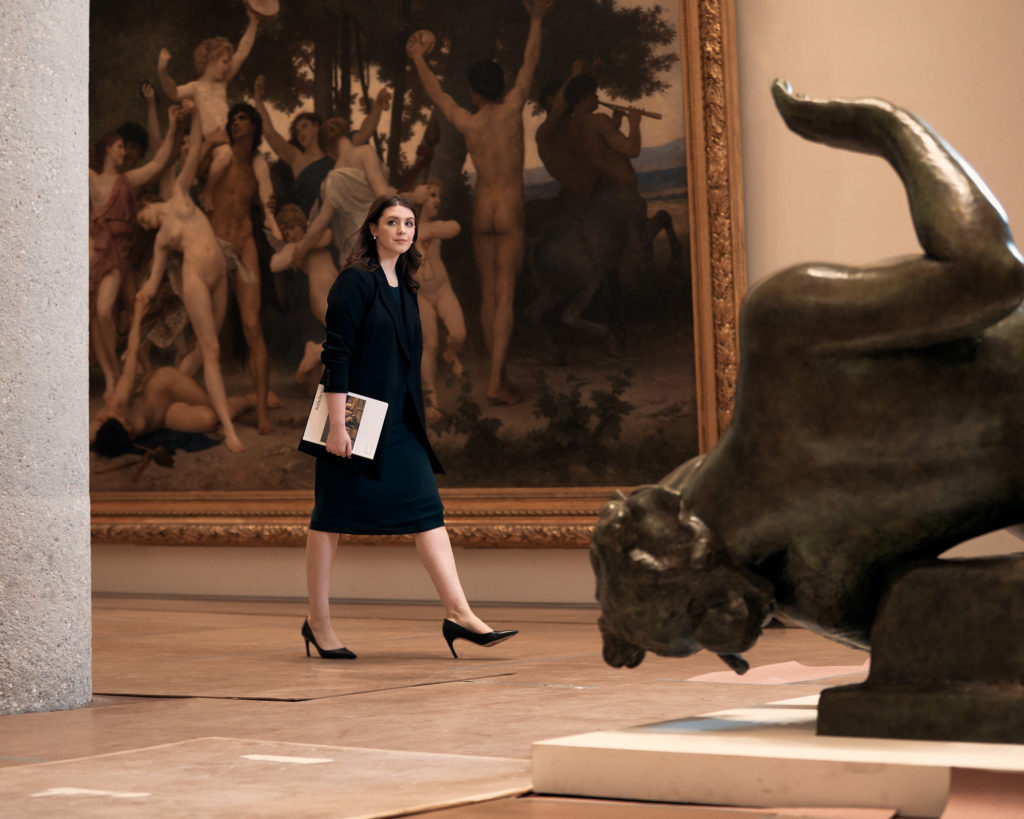
Kayla wears the Nanette dress, the Tamar blazer, and the Ginger pumps.
I WAS VERY MUCH EXPOSED TO THE ARTS as a kid. My parents both work in the art world too, and we were the type of family that, when we traveled, would always go to museums and art fairs. I didn’t really rebel against it, but when I went to college, I was planning to be a psychology major. Then I hated all of my psychology courses, but I loved art history. After my first semester, I called my parents and said, “I think I want to study art history.” I wasn’t sure what kind of career I wanted, but I knew that those classes were the ones where I felt like I was learning the most.
Want more M.M.? Sign up for our newsletter.
WHEN I WAS ABOUT TO GRADUATE, I started to panic. What do you do with an art history degree? So I applied to graduate programs, kind of late—the second semester of my senior year. Once I began grad school, I wound up doing a fellowship program at the Deerfield Museum in Deerfield, Massachusetts. That program focuses on historic houses, and I wrote a long and extensive research paper for their library while I was there. I figured I’d go into the nonprofit side of the art world—maybe work in a museum. But then I got a job at Christie’s, and I realized pretty quickly that my personality was a better fit for the commercial side of the art world, which tends to be more fast-paced. While I loved my internships at museums and small historic houses, I’m better suited for many different tasks rather than large research projects that take months or years. I thought, “I can either look at the same 100 works of art for the next ten years, or I can look at 100 new works of art every month.”
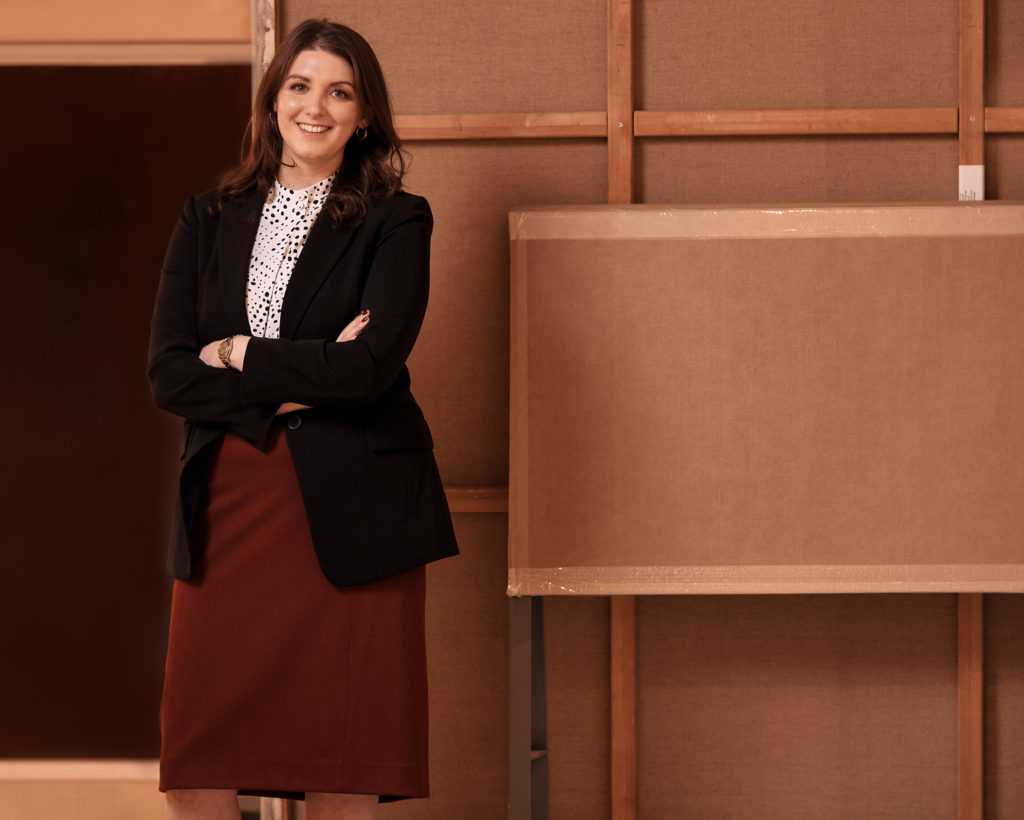
Kayla wears the Cristeta top, the Carson blazer, the Dorchester skirt, and the Claressa earrings.
I GREW UP IN THE HUDSON RIVER VALLEY, so a lot of 19th-century American landscape paintings are very familiar to me—I know the towns or mountains or streets or waterfalls that are depicted in those works. Having a specialty in that area just stuck. I love that American art is such a diverse category, with a lot of variety. I might handle a George Washington portrait, then a Norman Rockwell. It’s a huge spread, and not a lot of other categories can boast that.
MY JOB ENTAILS A LOT OF RESEARCH. We warranty everything that we sell, so we always have to make sure that A) it is what we think it is, and B) it hasn’t been stolen or restituted. I don’t encounter stolen or restituted works as much in American art, but my colleagues in European art occasionally come across works that were stolen during World War II. We work with groups like the Art Loss Register to make sure that everything is on the up and up, and that there are no gaps in ownership. There’s a lot of due diligence that happens on the back end before an auction catalog goes to press.

Kayla wears the Loretta top and the Mabel necklace.
ONE OF THE REASONS I LOVE WORKING at Sotheby’s is that I get access to so much material. In the American Art Department, I handle anything that was created by an American artist between 1790—like colonial-era portraiture—all the way up to pre-war, so 1945, with some exceptions. That covers a pretty wide variety of genres. Last fall, we sold three Georgia O’Keeffe paintings, and getting to go to the Georgia O’Keeffe Museum and look through their storage was definitely a highlight of my career. When I get to see something very up close that’s in every art history textbook, it’s different from seeing it in a gallery space. When I’m in museums, I often get told by security guards to step back. Part of what we do is inspect the condition of an artwork, and you have to touch the surface in order to do that. Sometimes I forget that I’m supposed to keep my distance when I’m in a public space!
ANOTHER BIG COMPONENT OF WHAT I DO is work with people. I enjoy that social aspect, which is good because it’s important to establish a good rapport with clients. When I’m meeting with people, I’m careful to do my homework. Some clients want to come in and see very specific works by particular artists, and I do a lot of research and reading beforehand. I always want to be prepared and able to speak freely and openly, and have opinions and not be stifled because I don’t know what to say.
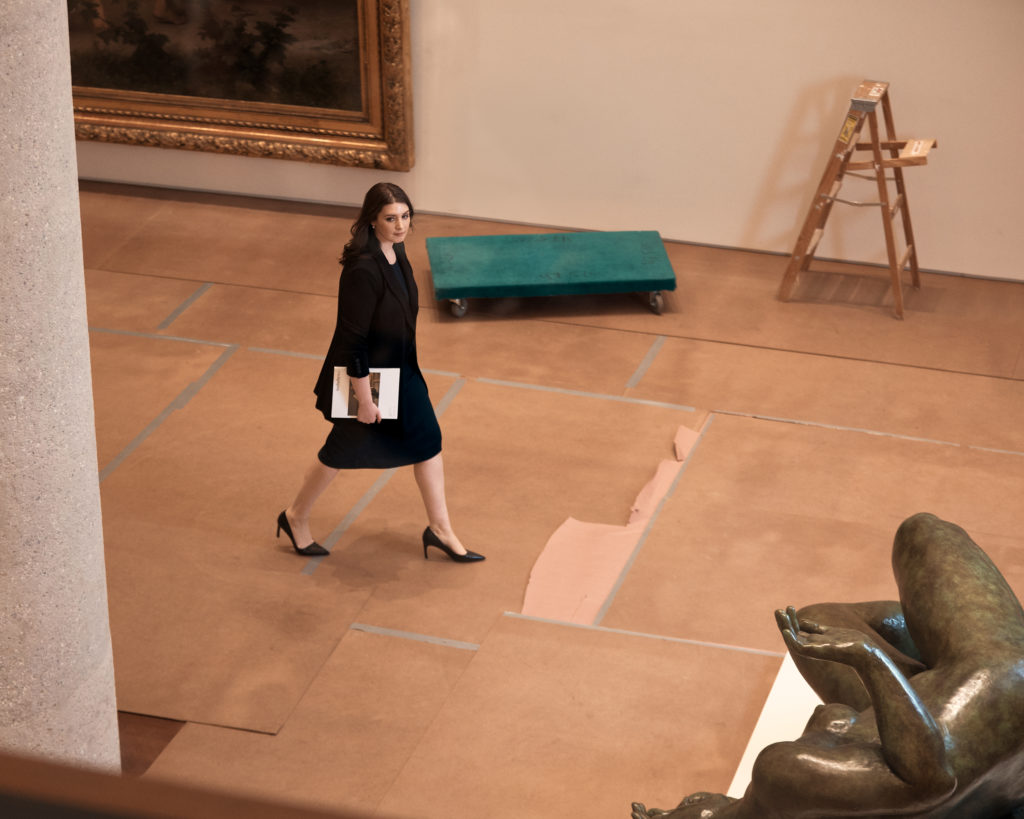
Kayla wears the Nanette dress, the Tamar blazer, and the Ginger pumps.
ESPECIALLY WHEN I WAS YOUNGER, people would come in and want to meet with a specialist, and they’d be surprised to find it was me. Sometimes they’d say something like, “Oh, but you’re so young for what you do.” I used to take that personally, and worry that people wouldn’t take me seriously. But I don’t get that response as much anymore. And I’ve learned that it’s probably an asset to be young and able to do what I do. Now I just embrace it. As long as I’m confident and competent, I believe that people will take me seriously.
I’VE ALSO LEARNED TO TRUST MY INSTINCTS. Last May, we sold this wonderful tempera painting of a farmer holding a pig, by N.C. Wyeth. We asked $2.5 to 3.5 million, which was the highest estimate ever placed on an N.C. Wyeth at auction. But the subject was quite polarizing. Not everybody wants to look at a farmer holding a giant pig in their living room. Still, I chose to put it on the cover of the auction catalog, because it looked so quintessentially American to me. Some people were shocked I put a pig on the cover of the catalog, other people loved the picture and it wound up selling for $5.98 million, which set a new world auction record for the artist.
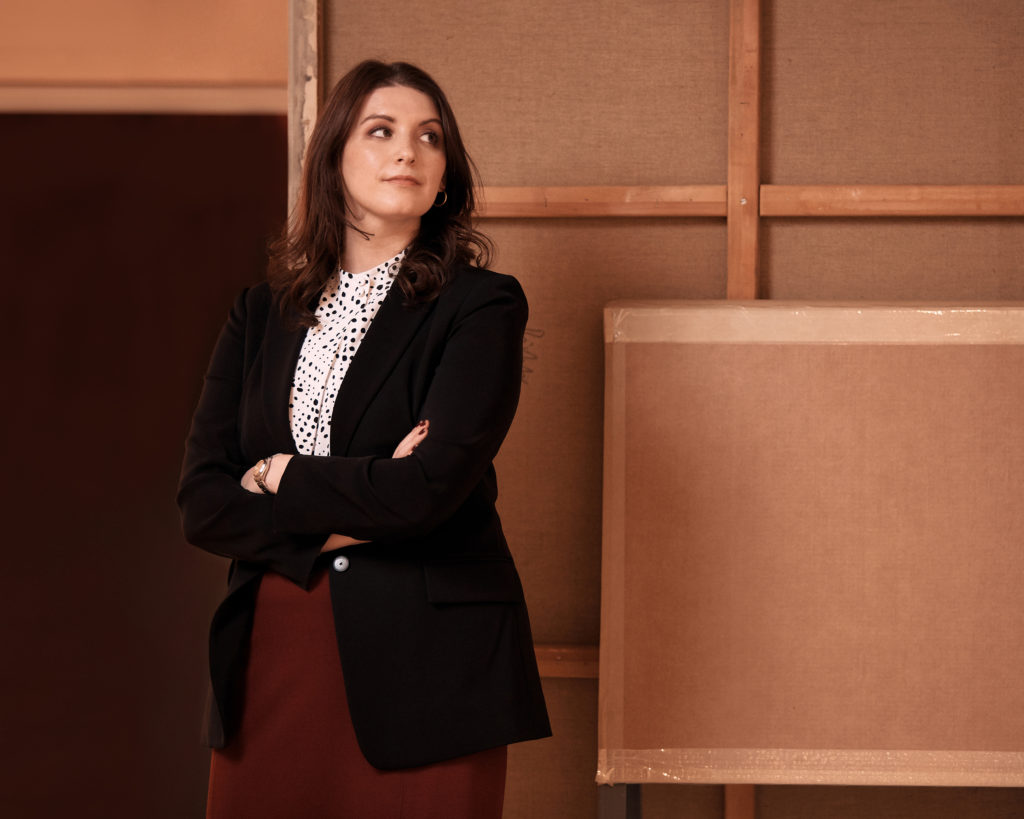
Kayla wears the Cristeta top, the Carson blazer, the Dorchester skirt, and the Claressa earrings.
IT’S AN INCREDIBLE FEELING to sell something that sets a new benchmark for its value. The adrenaline rush during an auction, when things are going well and selling for record prices—there’s nothing like it. At the same time, there’s a lot of pressure riding on these auctions. Our department has a major auction twice a year, and they usually bring in more than $30 million. There’s a lot you can do to make sure things go well, but there’s also a lot that’s out of your hands. And that can be very nerve-wracking.
PERSONALLY, I TEND TO BUY A LITTLE BIT OF EVERYTHING. I have works on paper, drawings by American artists, and some prints and photography by contemporary artists. I don’t own anything that’s worth a huge amount of money; it’s just stuff that I love. I like to browse what’s coming up at smaller auction houses in Connecticut or Westchester or New Jersey, and I always go to the Affordable Art Fair. I also really like sculpture; I think it’s an undervalued category in the art market. A lot of collectors have difficulty understanding bronzes because they were often cast in multiples, but I own a few marbles and bronzes.
IF YOU’RE INTERESTED IN BUYING ART, I think it’s an important step to expose yourself to it as much as possible and start to take note of things that intrigue you—things you’d want to live with and enjoy looking at every day. Once you have a good sense of your aesthetic, you can start to do some research on what’s available at your price point. For example, if you like contemporary art, you could start by collecting prints and multiples or works on paper before you invest in an oil painting. And buy what you like, because the art market ebbs and flows. What’s in fashion today may not be in fashion ten years from now. If you eventually want to sell whatever you’ve bought, hopefully you can make a decent profit, but if you can’t, you should at least enjoy it while you own it.
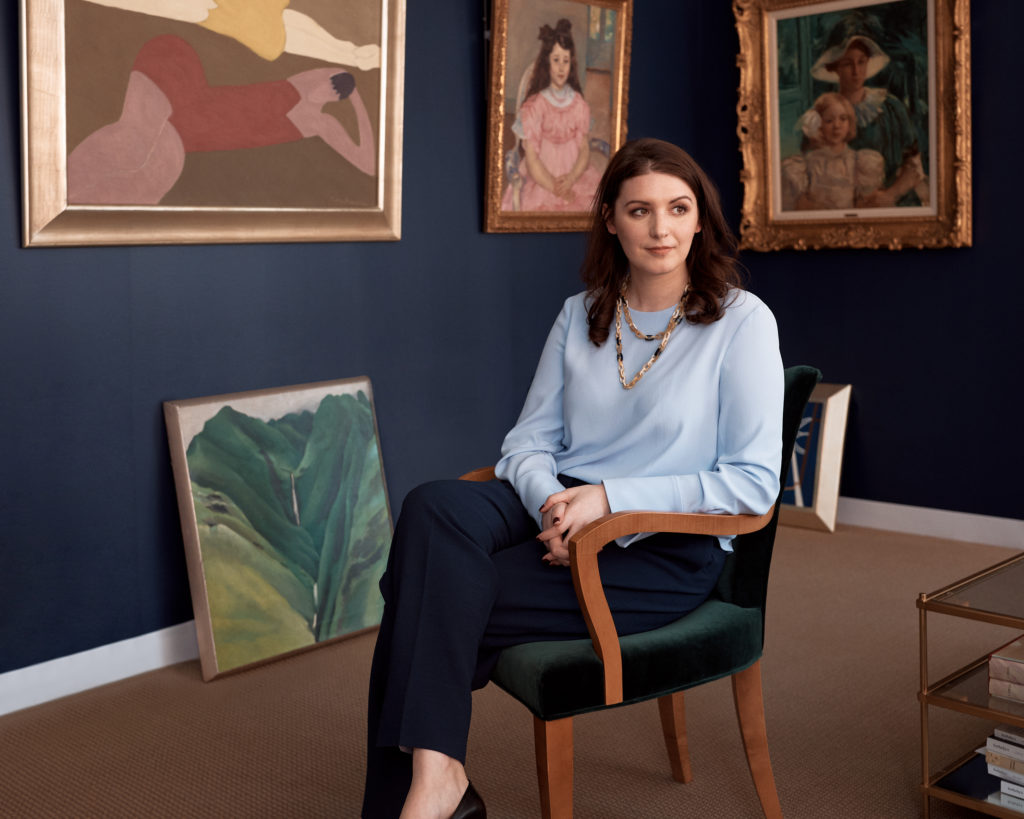
Kayla wears the Loretta top, the Elliott trouser, and the Mabel necklace.
WHENEVER I’M WORKING WITH A CLIENT ON A CONSIGNMENT, we really are working together. We only do well if the consigner does well. It’s very much a partnership, and some people forget that—they see auction houses as a middle man who’s looking to take a cut, when in reality; we’re here to work on their behalf and present an artwork for sale successfully. I often find the best deals are when a specialist and a client are in constant contact and work together to make sure that something is accurately presented in a beautiful way and marketed properly. It feels really rewarding when it all works out.
SOMETIMES PEOPLE ASK, “Are there any moments that you feel like you’re super important?” And while I truly believe that there’s no such thing as an art “emergency,” there are moments when an art sale can make a huge impact on an institution or a community. Last fall, we sold a piece on behalf of a small public library in New Jersey, which achieved a record price for the painting that was going to fund their operation for the foreseeable future. They were so thrilled, and I know that those funds are very meaningful to them. When the library’s director hugged me after the sale, it made me feel like what we do really matters.
Photographs by Jeff Allen. Stying by Sam Michel.





